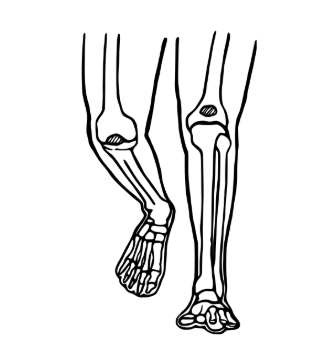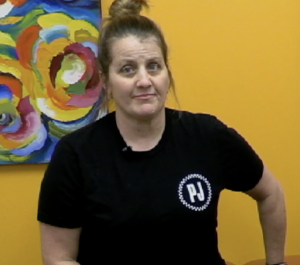When a Wrench Gets Thrown Into the Body’s Gear System
How Your Big Toe Impacts Your Hip & Lower Back
If it’s happened to you, the sensation is unforgettable.
If you’ve seen it happen, it’s just as shocking.
And if you’ve ever thought about doing it to someone out of spite — I hope you reconsidered.
What am I talking about? Putting a stick into the wheel of a moving bike.
The motion stops instantly. The wheel locks up, and the bike jerks forward — with the sudden loss of momentum.
What happened to Katie wasn’t quite as dramatic, but her story, below, highlights an incredible aspect of how our body’s structural system works — because, yes, our body has its own version of gears, rods, and cranks that allow you to move smoothly and efficiently.
The “Gears and Rods” of the Leg: How They Move You
 Your body is a masterfully designed machine. If muscles had to do all the work in order for you to move, you’d be exhausted within minutes. Instead, your structural system works with mechanical efficiency to make movement smooth and effortless.
Your body is a masterfully designed machine. If muscles had to do all the work in order for you to move, you’d be exhausted within minutes. Instead, your structural system works with mechanical efficiency to make movement smooth and effortless.
Here’s how the lower body’s mechanics work together:
🔹 Crank & Rod: Your big toe connects to the long metatarsal bone in your foot, which rotates to absorb impact from the ground.
🔹 Gears & Rods: The first metatarsal connects through the ankle to the tibia (shin bone), allowing the tibia to rotate, absorb force, and turn the femur and hip.
🔹 Rod, Gear & Engine: The femur and hip rotation connects to the pelvis, engaging the large muscles of the hip and core for balance, power, and speed.
Disrupt this intricate mechanical chain and movement will become stiff, inefficient, and exhausting.
What Stops This Flow of Motion?
A breakdown in the big toe, foot, or ankle can jam the entire system — like throwing a wrench into a machine, or stick into the bike wheel. Common causes include:
🚨 A Big Toe Injury – Even minor trauma can stiffen movement.
🚨 Injury to the Inner Side of the Foot – This disrupts the rotation of the tibia and femur.
🚨 A Cast or Surgery on the Foot/Ankle – Immobilization stiffens muscle interactions resulting in limited bone movement.
In reality, muscles that are not coordinating from segment to segment is all it takes to shut the movement flow down. If doesn’t mean you can’t move, but you will lose efficiency and fluency.
Katie’s Story: A Foot Surgery That Locked Her Gears
 Katie played high-level soccer for years, enduring repetitive stress on her big toe. Eventually, the alignment of her foot bones was so off that she opted for surgery to fix it.
Katie played high-level soccer for years, enduring repetitive stress on her big toe. Eventually, the alignment of her foot bones was so off that she opted for surgery to fix it.
We worked together after her first surgery to reset her gait mechanics after years of compensating. She was hopeful to return to playing soccer pain-free — but something still wasn’t right.
What Else Did We Find?
Katie’s X-ray revealed hardware (screws) holding her first and second metatarsals together. We encouraged her to circle back to her specialist to ask if removing the screws was an option in the future. Why?
🚨 Big problem
With those bones locked in place, the natural movement chain of her foot, ankle, shin, knee, and hip was completely shut down at the bottom — the screw placement functioned like the stick in the gears.
Two Years Later: Removing the Hardware & Finding Relief
For two years, Katie felt constant stress in her foot and leg. She finally convinced her surgeon to remove the hardware, hoping for relief.
The result? Immediate improvement to the stress she felt.
Two weeks after surgery to remove the hardware, I met with Katie to see how her recovery was going, and how Bridging could add some support. You can see what we found in the YouTube video.
How Bridging® Helped Katie Recover Faster
The primary reset to help Katie move more easily was the mechanical link between her ankle and knee. This mechanical connection had likely been off since BEFORE her first surgery — but Bridging helped restore it quickly.
Why is this reset important?
🔹 When your ankle flexes, it triggers the shin bone (tibia) to rotate.
🔹 This rotation signals the quadriceps to activate, stabilizing the knee and hip.
🔹 When this sequence is disrupted, movement feels stiff, awkward, and exhausting.
You will be able to see what we found and how we helped in the video.
Why Exercise & Stretching Didn’t Work
🚫 Traditional rehab exercises don’t reset these mechanical links.
🚫 Stretching only works on muscles — not the neuromuscular sequencing of movements.
🚫 Neither exercise nor stretching fix movement patterns that are ‘offline’.
✅ Bridging is different. It provides targeted support to reset specific muscle coordination, turning sidelined movement sequences back online.

